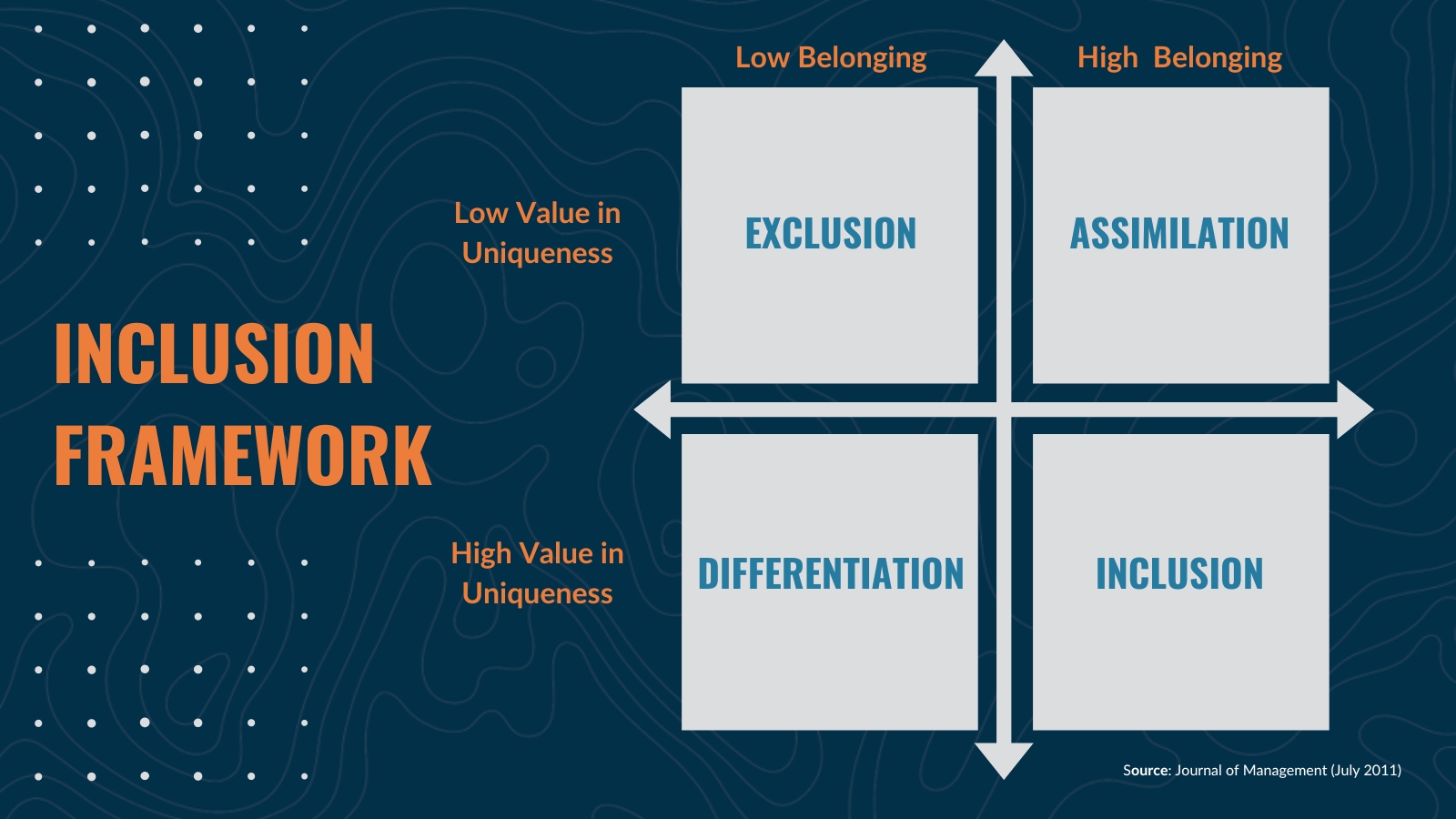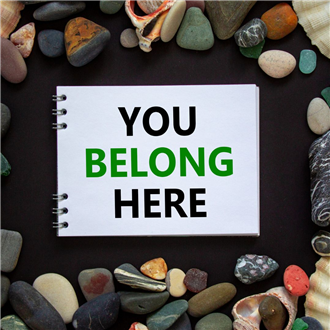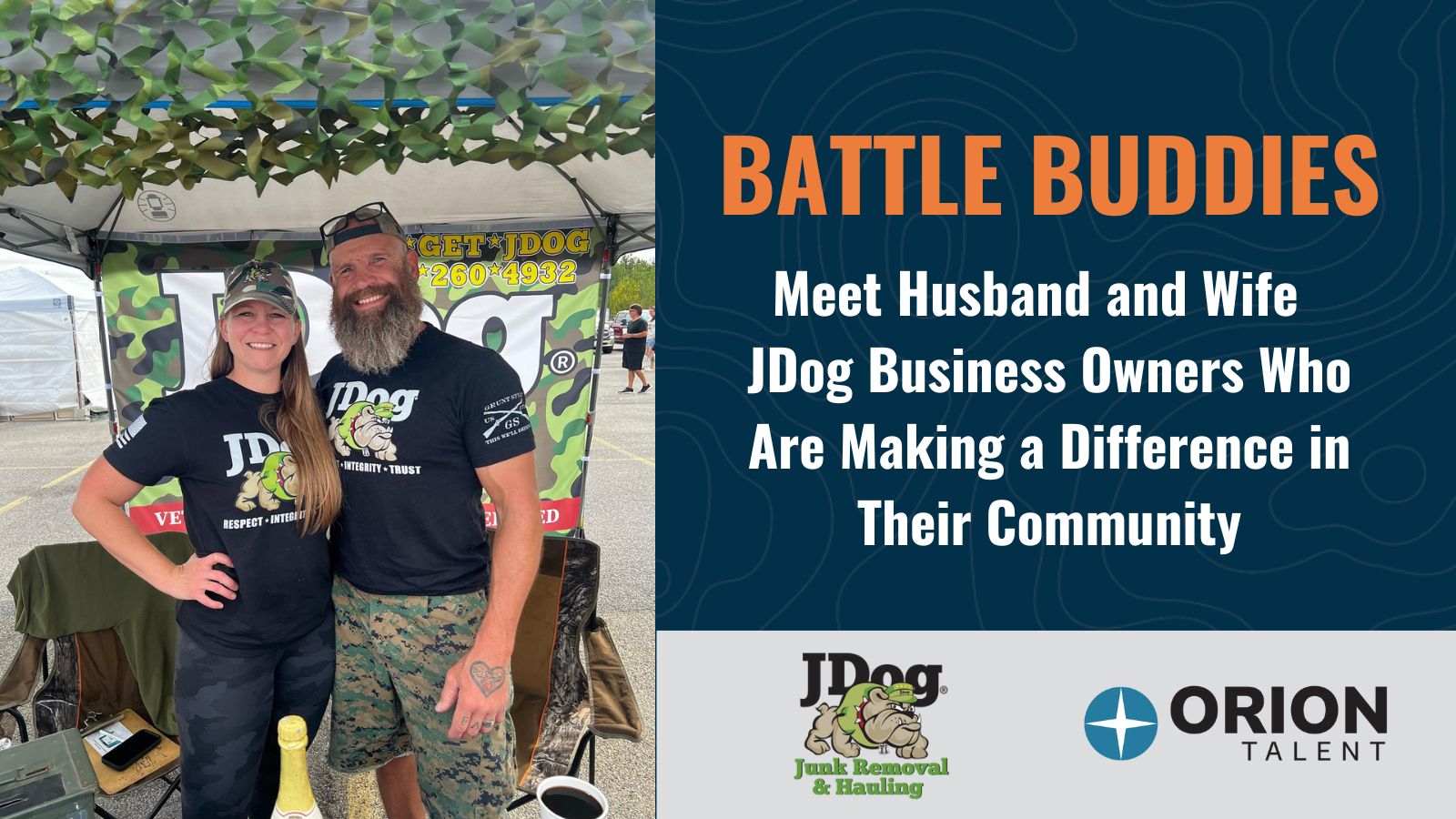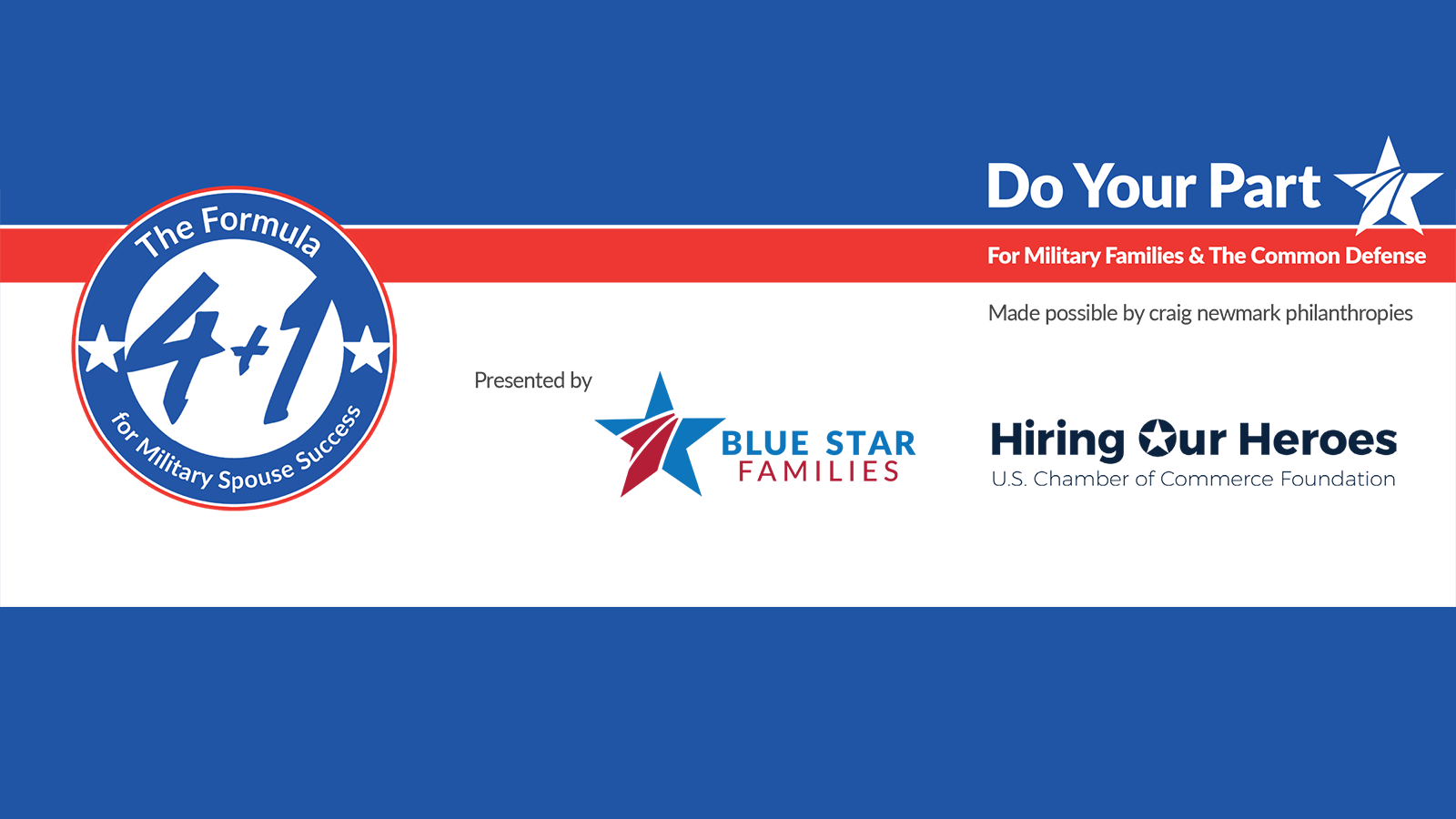.jpg)
It’s no secret that Diversity, Equity, and Inclusion (DEI) matter in the workplace. Creating a company culture where diverse individuals feel welcomed and included is an admirable goal, and this goes far beyond diversity hiring goals.
A diverse workforce and inclusive company culture aren't just “nice to have” features. It’s a mindset change starting at the top of your organization and impacting every aspect of the employee experience including recruitment, hiring, professional development, and retention efforts. While many companies have implemented DEI strategies, not all lead to inclusion. Before you can create an action plan to develop or improve your DEI strategy, it’s helpful to know where your organization stands today. The Inclusion Framework is a useful tool. This blog post explores the Inclusion Framework and defines common DEI terminology to help you develop a better understanding of where your DEI efforts stand today and help you determine areas of improvement.
Where Do Your Organization’s Efforts Fall on the Inclusion Framework?
How individual employees fit into your organization greatly contributes to their sense of belonging. When an individual is an accepted member of a group (belonging) and the group values their unique characteristic (age, gender, education, background, religion, etc), then the group is more inclusive. The Inclusion Framework below provides a sense of how these components fit together. We’ll discuss each individually.

Don is a professional in his 50s and has just started at a new tech firm, where he works closely with teammates freshly out of college. He has decades of industry experience and is excited to bring his skills to the table, though a little anxious about how he’ll bridge the generational divide. How Don relates with his team members will impact his experience, performance, and even his perception of company culture. Let’s explore how Don reacts to being placed in each quadrant of the Inclusion Framework as we learn more about what exclusion, assimilation, differentiation, and inclusion look like in action.
Exclusion: Low Value in Uniqueness and Low Belonging
Cambridge Dictionary defines exclusion as the act of not allowing someone or something to take part in an activity or to enter a place. According to the Journal of Management, exclusion in a group or workplace setting is when an individual is not treated as an organizational insider with unique value in the work group while other employees or groups are insiders. 
When we consider inclusion vs. exclusion, it’s helpful to consider in-groups and out-groups. Humans unconsciously tend to gravitate towards others like them (similarity bias) and this certainly extends to the business world. In-groups form when people with similar characteristics (appearance, thinking, decision-making, problem-solving) are grouped together or choose to work together. Those who are part of the in-group may not notice there’s even a problem, because being part of the in-group feels great. Members of an in-group are more likely to be recognized, promoted, or given better assignments. Leaders may not recognize the existence of in-groups initially either because in-groups tend to work well with and support their leaders while producing results. Yet in-groups can be exclusionary.
Team members who do not fit the mold are relegated to the out-group. These workers are likely to feel demoralized, disrespected, and unheard, and they’re less likely to get promoted or to participate in team discussions. It may seem that compensation, rewards, and recognition are unfairly awarded to the in-group. Poor productivity and high turnover may be symptoms of an in-group/ out-group dynamic within your organization.
Let’s consider Don. His new organization has strong us-versus-them team dynamics. As a mature team member with different life experiences, he feels like he does not fit in. While his Boss seems pleased with the group’s work overall (they are high performers who produce great results), Don doesn’t feel like he can get a word in edgewise during meetings and he resents being left out of key planning sessions that happen at informal social events outside of work hours. His team assumes he would not attend and doesn’t invite him to join. His lack of participation is viewed as a lack of interest, and as a result, Don doesn’t receive choice assignments. He’s experiencing Exclusion. If he’s not brought into the group, made to feel welcome, and appreciated for the unique skills he brings to the table, it’s unlikely Don will find satisfaction in this role and it’s likely he’ll move to a different role or organization where he feels appreciated.
Exclusion is the opposite of belonging. The first step leaders should take is to recognize it and observe how similarity biases may be affecting their company culture. Have in-groups and out-groups formed within your organization? What can be done to close the gaps between these groups and lead to a more inclusive work environment? Encouraging team members to get to know one another better, giving everyone equal time in meetings to present their ideas, and diversifying team structure and work groups are great places to start.
Assimilation: Low Value in Uniqueness and High Belonging
Several months into his new role, Don seems to be doing well. He has integrated into his work team and joins them for happy hour at a nearby sports bar several times each week. Don is now experiencing a high sense of belonging. Yet he’s not experiencing an inclusive work environment. If Don does not attend these social events, he will not be considered part of the group. Don must put aside his outside responsibilities as a parent and husband in order to attend happy hour events with his workmates, causing his personal life to suffer. In addition, he must feign interest in sports in order to connect conversationally and be part of the in-group. But since business strategies seem to formulate around social hour within this group, Don feels he cannot risk missing it even though it’s not his style. Don has assimilated into the group (belonging), but this is conditional on conforming to the dominant group culture and downplaying his differences or needs (uniqueness).
Merriam-Webster Dictionary defines assimilating as to absorb into the cultural tradition of a population or group or to make similar. In the Assimilation quadrant of the Inclusion Framework, an individual is treated as an insider only if and when they conform to organizational or dominant cultural norms and downplay their uniqueness. The non-dominant group feels pressure to fit in with the in-group in regard to appearance, actions or behavior, thoughts, etc. Individuals experience a high sense of belonging, but a low value in uniqueness.
to make similar. In the Assimilation quadrant of the Inclusion Framework, an individual is treated as an insider only if and when they conform to organizational or dominant cultural norms and downplay their uniqueness. The non-dominant group feels pressure to fit in with the in-group in regard to appearance, actions or behavior, thoughts, etc. Individuals experience a high sense of belonging, but a low value in uniqueness.
This looks like many things: changing the way one speaks or styles their hair to fit into the dominant company culture, participating in or accepting inappropriate jokes or banter, talking about sports teams or events because that’s what the team does, etc. Code-switching, passing, and covering are a few methods individuals utilize to assimilate and feel like part of the group. In the process, these actions hide or downplay differences. Employees are faced with the dilemma of whether they should suppress their true identity in order to fit in and be successful at work, or whether they should bring their whole selves to work and risk not being accepted as part of the group. Assimilation in the workplace can stifle the unique strengths and perspectives that diverse employees bring to the table and does not lead to inclusivity.
Social listening, surveys and talking to employees at every level of your organization are good ways to get a feel for whether employees believe they can be themselves at work. Employers should encourage a culture that celebrates individuality.
Differentiation: High Value in Uniqueness and Low Belonging
 In some cases, DEI efforts are only skin deep. Their implementation creates positive press and the appearance of an inclusive, diverse workplace, but these initiatives do not truly become part of company culture. The word tokenism comes to mind, defined by the Dictionary Britannica as the practice of doing something (such as hiring a person who belongs to a minority group) only to prevent criticism and give the appearance that people are being treated fairly. Hiring someone because of a differentiating factor like race or gender alone can be considered tokenism. It’s a symbolic gesture toward inclusivity without the work of becoming truly inclusive.
In some cases, DEI efforts are only skin deep. Their implementation creates positive press and the appearance of an inclusive, diverse workplace, but these initiatives do not truly become part of company culture. The word tokenism comes to mind, defined by the Dictionary Britannica as the practice of doing something (such as hiring a person who belongs to a minority group) only to prevent criticism and give the appearance that people are being treated fairly. Hiring someone because of a differentiating factor like race or gender alone can be considered tokenism. It’s a symbolic gesture toward inclusivity without the work of becoming truly inclusive.
According to this Forbes article, some ways employees experience tokenism include:
False company marketing and branding
An underrepresented employee is featured in interviews, marketing materials, client meetings, and more to make the organization appear more diverse than it is in reality. Sometimes, a company’s website appears diverse, but this doesn’t reflect its truly homogenous makeup.
Little more than a seat at the table
Individuals from underrepresented groups who are selected to lead DEI efforts they are not ready or qualified to take on without a supportive team are often times set up for failure. It’s not enough to simply have a diverse workforce throughout organizational structures just for the sake of diversity.
Community representation
When a diverse employee is asked to speak as a representative of their minority group or to mentor and sponsor those from a similar background, this can be tokenism. Being singled out for race, ethnicity, gender, identity, religion, or other unique qualities differentiates people. Symbolic diversity falls into this category too- hiring a diverse individual to check a box is not inclusion.
In the Differentiation category of the Inclusion Framework, an individual is highly valued for their uniqueness, but experiences a low sense of belonging. They are not treated as an organizational insider in their work group. Yet their unique characteristics are considered to be valuable and required for group or organizational success. Individuals in this category may feel less than welcome and more like a prop than a true teammate.
If Don was hired exclusively because of his age or ethnicity in order to check a box/ meet a hiring goal and he is not valued because of his skills or experience, it’s unlikely he’ll become an integrated team member and find his purpose within this organization. In addition, being regarded by his colleagues as a token hire may harm his mental health in the long term.
Inclusion: High Value in Uniqueness and High Belonging
Don’s new organization is committed to inclusivity and he feels like he truly belongs. He isn’t forced to conform to dominant culture norms to fit in or to hide or downplay any aspect of himself. His teammates are accepting and cooperative and make him feel like part of the group just for being himself. They appreciate the unique attributes he brings to the table and Don feels like his voice is heard. As a result, his entire team is more productive, more innovative, more connected, and exercises greater decision-making capabilities. Since Don is engaged and feels purposeful in his work, he’s likely to stick around and continue contributing his valuable skills and experience to this organization.
dominant culture norms to fit in or to hide or downplay any aspect of himself. His teammates are accepting and cooperative and make him feel like part of the group just for being himself. They appreciate the unique attributes he brings to the table and Don feels like his voice is heard. As a result, his entire team is more productive, more innovative, more connected, and exercises greater decision-making capabilities. Since Don is engaged and feels purposeful in his work, he’s likely to stick around and continue contributing his valuable skills and experience to this organization.
Inclusion is the foundation of a thriving workplace, and this is the fourth and final square of the Inclusion Framework. Cambridge Dictionary defines inclusion as the act of including someone or something as part of a group, list, etc, or a person or thing that is included. In the workplace, inclusion can be measured by a sense of belonging, connection, and community and the ability to authentically bring one’s whole self to work. In an inclusive environment, the individual feels like they belong and their organization highly values their uniqueness. They are treated as an insider and encouraged to retain their uniqueness within the workgroup.
Employees of all identities working in an inclusive environment feel welcomed, valued, respected, included, represented, and accepted for who they are. An inclusive work environment is collaborative and provides support, resources, and growth opportunities for individuals from all backgrounds. Inclusion and a sense of belonging go hand in hand. National University puts the difference between diversity and inclusion this way: Diversity is the mix, and inclusion is getting the mix to work together. When this happens, you’ll create a company culture that attracts and retains top talent.
An inclusive work environment doesn’t happen by chance. It’s an active, participatory, and purposeful journey that never ends. Cultural inclusion starts at the top and permeates every aspect of company culture. Create inclusive recruitment strategies, encourage employee resource groups, conduct regular diversity and inclusion surveys to gauge the effectiveness of your efforts, provide multiple ways for employees to give feedback, and implement feedback mechanisms to address concerns. Providing mentorship and career development opportunities for underrepresented groups can also ensure a more inclusive career progression.
Why Inclusion Matters in the Workplace
As employers, embracing diversity and inclusion is not just a buzzword; it is a powerful strategy to create a dynamic and high-performing workplace. By recognizing and addressing biases, celebrating individuality, fostering cross-functional collaboration, and empowering employee voices, organizations can build a culture of inclusion that brings out the best in every employee.
An inclusive work environment contributes greatly to a positive company culture. Employees who feel like they have a purpose and belong in your workplace are more loyal, less likely to leave, and will positively impact your bottom line. Diversity of thought and experience fosters a wide range of perspectives and ideas, leading to creativity and innovation that will drive your organization forward with more comprehensive and effective solutions. Where on the Inclusion Framework do you see your company today? What’s your goal and how can you get there? We encourage you to keep learning. This DEI webinar series is a great place to start.
If you’re not sure where to start or could use a little help along the way to meet your diversity hiring goals, be sure to check out Orion Talent’s HirePurpose™ Diversity Sourcing and Talent Attraction Solution. We connect industry-leading companies with diverse job seekers desiring an inclusive workplace while helping our clients build a culture where all employees can bring their authentic selves to work each day.
Archives
- April 2025
- March 2025
- February 2025
- October 2024
- May 2024
- March 2024
- February 2024
- January 2024
- December 2023
- November 2023
- October 2023
- September 2023
- August 2023
- July 2023
- June 2023
- May 2023
- April 2023
- March 2023
- February 2023
- January 2023
- December 2022
- November 2022
- October 2022
- September 2022
- August 2022
- July 2022
- June 2022
- May 2022
- April 2022
- March 2022
- February 2022
- January 2022
- December 2021
- November 2021
- October 2021
- September 2021
- August 2021
- July 2021
- June 2021
- May 2021
- April 2021
- March 2021
- February 2021
- January 2021
- December 2020
- November 2020
- October 2020
- September 2020
- August 2020
- July 2020
- June 2020
- May 2020
- April 2020
- March 2020
- February 2020
- January 2020
- December 2019
- November 2019
- October 2019
- September 2019
- August 2019
- July 2019
- June 2019
- May 2019
- April 2019
- March 2019
- February 2019
- January 2019
- December 2018
- November 2018
- October 2018
- September 2018
- August 2018
- July 2018
- June 2018
- May 2018
- April 2018
- March 2018
- February 2018
- January 2018
- December 2017
- November 2017
- October 2017
- September 2017
- August 2017
- July 2017
- June 2017
- May 2017
- March 2017
- February 2017
- January 2017
 RSS Feed
RSS Feed
Subscribe to Orion's Blog
Featured Blogs





.jpg)















